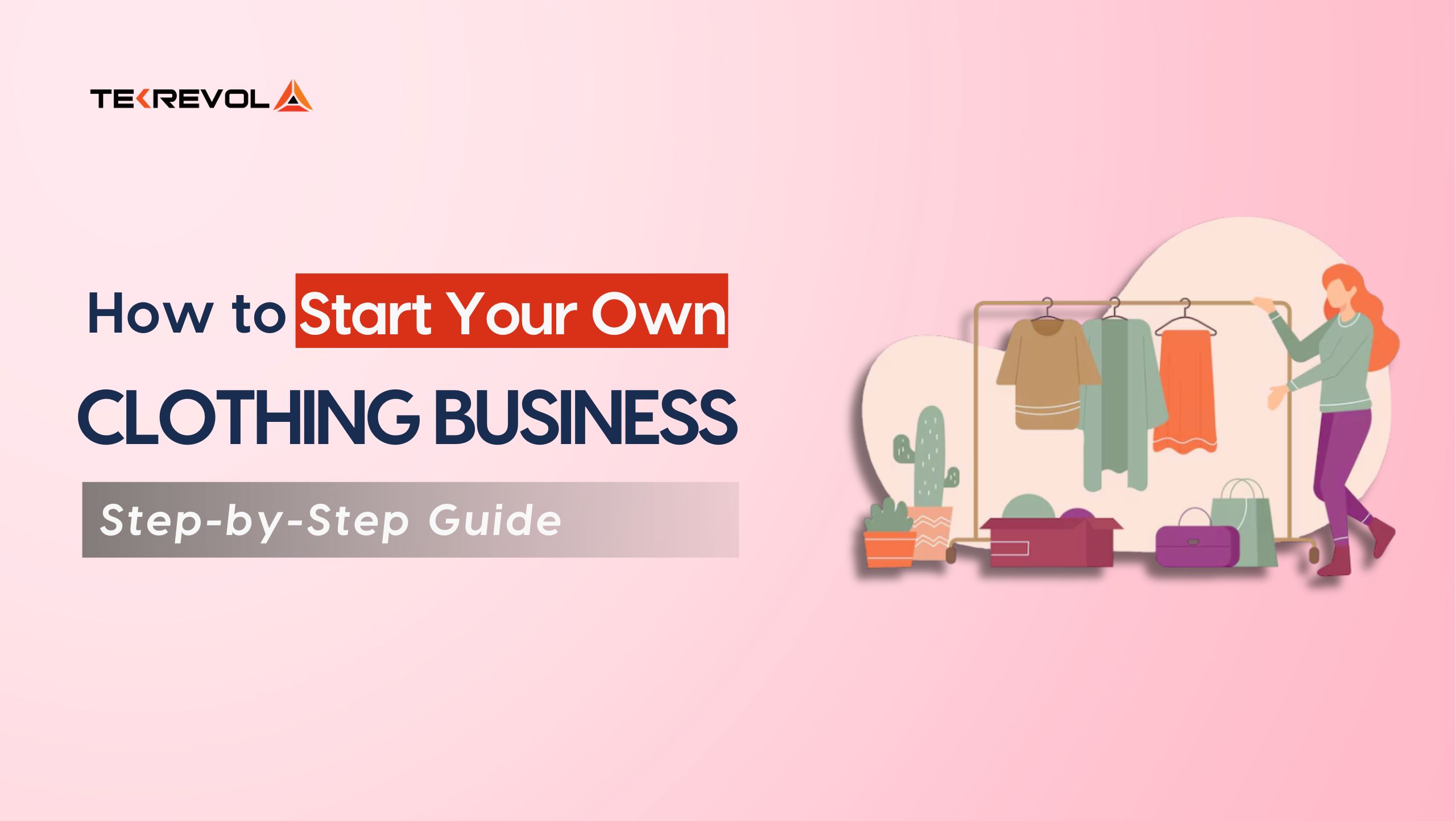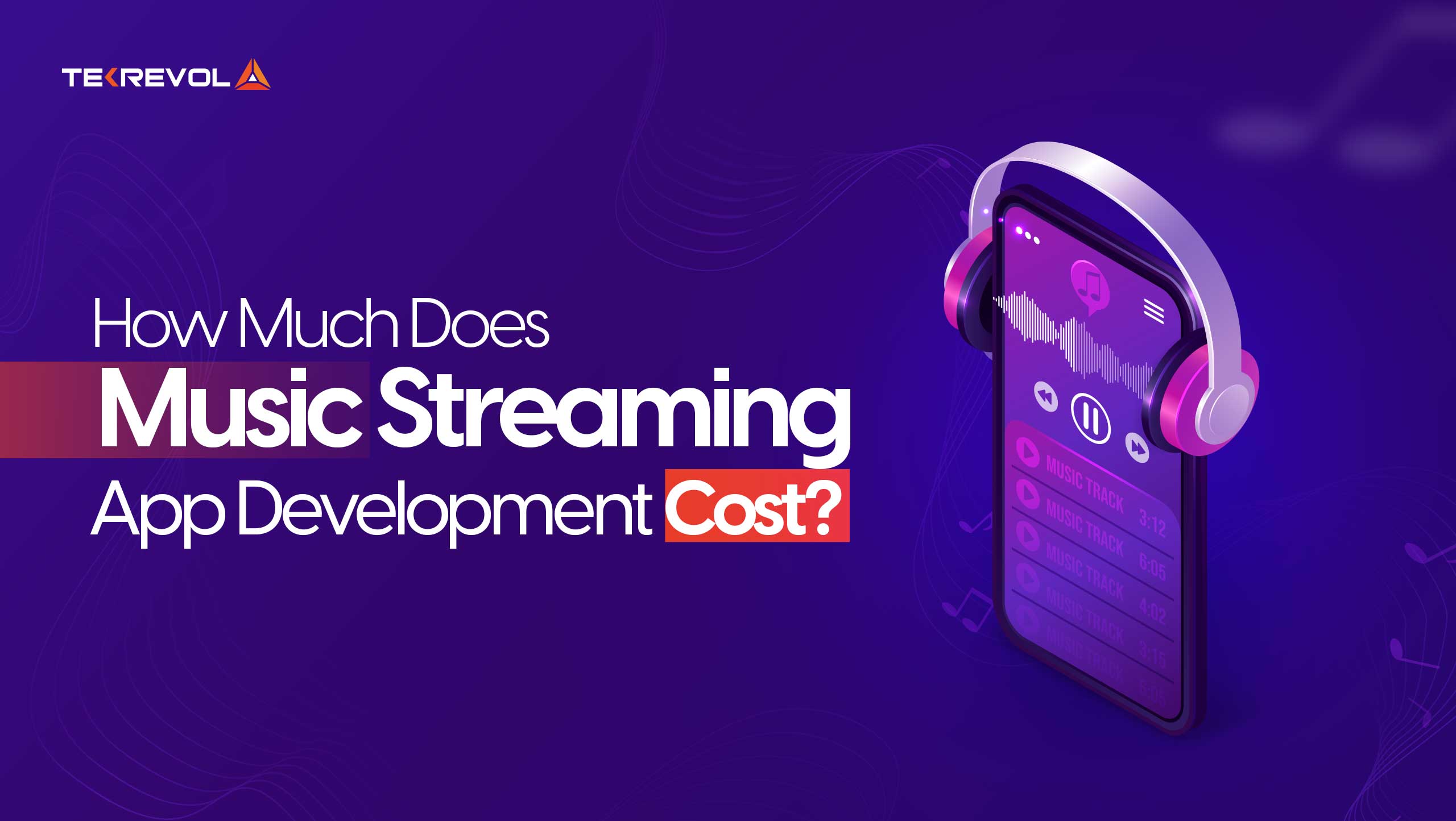According to Statista, the global fashion industry will be worth around $1.84 trillion by the end of 2025, compared to $1.73 trillion in 2024.
And that expansion is creating opportunities for new businesspeople, particularly those asking how to start a clothing business online.
Now it doesn’t matter if you wish to have a home-based boutique, a luxurious clothing company, or want to start a resale clothing business. Entering the fashion industry is no longer bound to a degree in design or a six-figure budget
All you need is the right tools and approach to get your brand off the ground. The fact that print-on-demand services, wholesale directories, and social-first marketing channels are readily available makes it simple to start and grow, whether you’re beginning from scratch or not.
In this blog, we’ll demonstrate how to start a clothing line with no experience, compare various business models, and provide you with the tools to create something real in 2025.
Why You Should Start a Clothing Business in 2025?
You should start a clothing business in 2025, mainly due to its bright potential that comes from a steadily expanding global fashion retail market and rapidly increasing consumer demands for sustainable and customized apparel options.
Besides, the clothing business is no longer the exclusive domain of those who can afford the big upfront investment in inventory and a warehouse. The rise of the creator economy, dropshipping platforms, social-first discovery, and e-commerce app development services has significantly reduced the entry barrier, thereby allowing solo founders can build scalable fashion brands on their terms now.
Global Fashion Trends and Forecasts
Clothing isn’t just about style anymore; it’s personal. Style has a message now, and Gen Z and Millennials are loud about it.
They shop brands that align with their values, reflect who they are and what they stand for, not just what’s trending. And they’re finding them on social platforms, not in malls.
Quickly scanning through the trends, we can understand why 2025 is the best time for starting an apparel company:
- Market Boom: The world’s apparel market is expected to hit $2.25 trillion by 2030, up from $1.84 trillion in 2025 (Fortune Business Insights).
- Sustainability: The current consumers are the ones concerned with the environment, so they are actively looking for green and ethical fashion items.
- Personalization: Social media greatly magnifies the demand for personalized, value-driven, and individualistic fashion.
- Disintermediation: The direct relationship between the buyer and the seller is created due to the absence of middlemen in the supply chain. Over 65% of Gen Z shoppers prefer buying from direct-to-consumer (DTC) brands instead of legacy retailers.
- Accessibility to Modern Tools: Small brands can get and use big business retail tools easily and at a fraction of the cost, from stock keeping to customer loyalty software, because of technological progress.

What Do You Need to Start a Clothing Business in 2025?
For starting your own clothing business in 2025, you need clarity on your niche, your launch strategy, and how you’ll promote your products.
Print-on-demand and pre-orders are examples of models that allow you to test your ideas with low upfront costs, and technology has removed many of the old barriers that once held small brands back.
McKinsey reports that 38% of fashion startups employ on-demand production to lower inventory costs and waste.
Difference Between Traditional and Modern Clothing Business Models
Traditional fashion businesses depend on mass inventory, physical stores, and a large initial investment.
On the other hand, these days brands employ digital channels, utilize customer data for real-time, and cooperate with delivery agents to test and grow their business more efficiently.
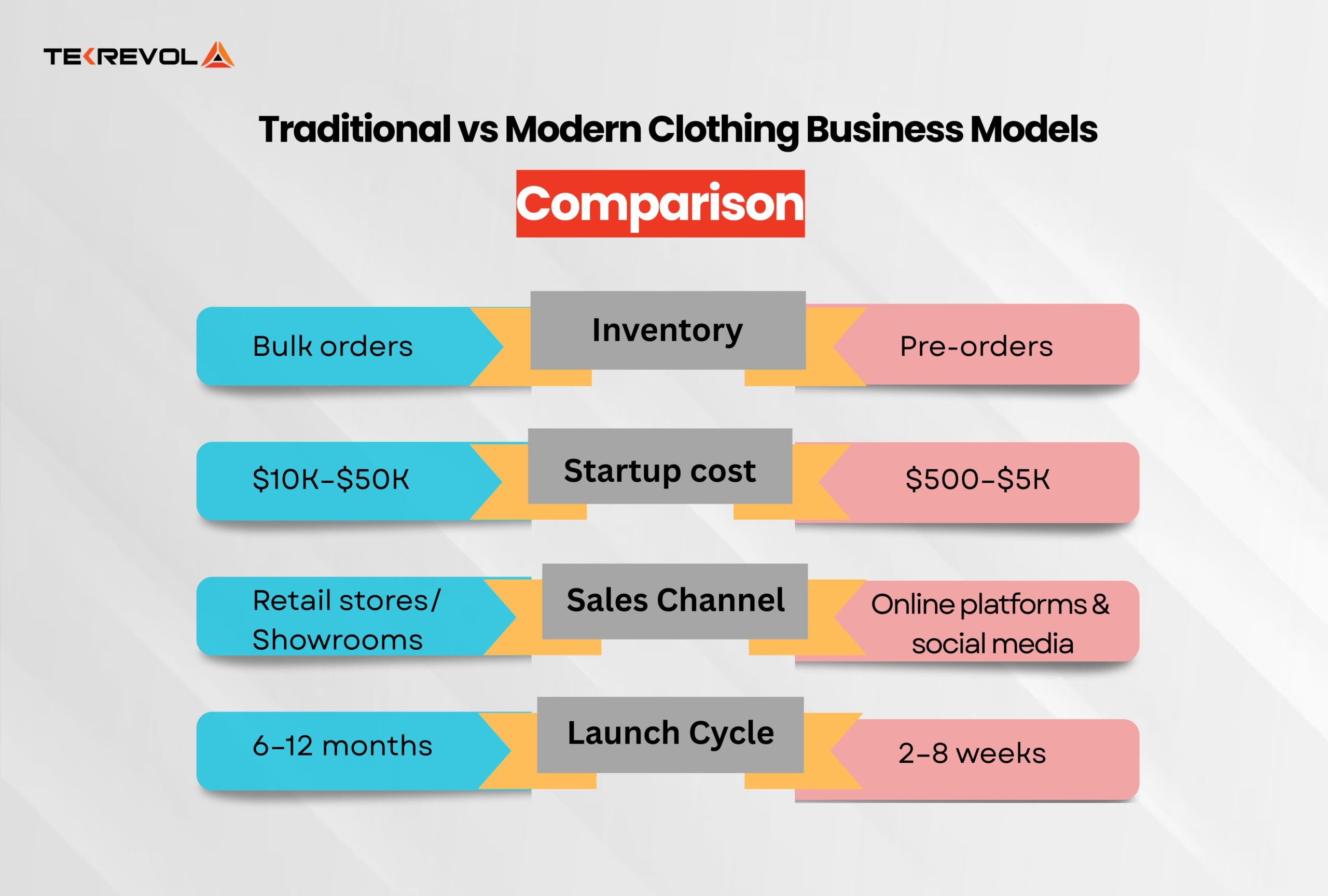
To support this shift, many emerging brands now use custom retail software solutions to manage inventory, track fulfillment, and sync with multiple channels, without needing a large ops team.
How Did the Pandemic Change the Fashion Startup?
The pandemic was a major accelerator. It pushed brands to reduce fixed costs, go direct-to-consumer, and test smaller product batches before scaling.
Founders learned to test ideas quickly, avoid overhead, and connect directly with consumers through content and social channels.
- Home-based brands replaced storefronts
- Influencers started launching labels with no design background
- Agile brands pivoted faster than traditional ones
How to Start a Clothing Business in 2025: 7 Essential Steps
To successfully start a clothing business in 2025, analyze the market for identification of your niche and competitors. Then, build your brand identity reflecting your niche. You also need to decide on business models and procurement strategies.
Later steps involve product design and testing, and market launch, utilizing social media and influencers’ powers to reach your target audience.
These are seven steps in total, as shown in the image, answering how to start a clothing business easily in 2025:
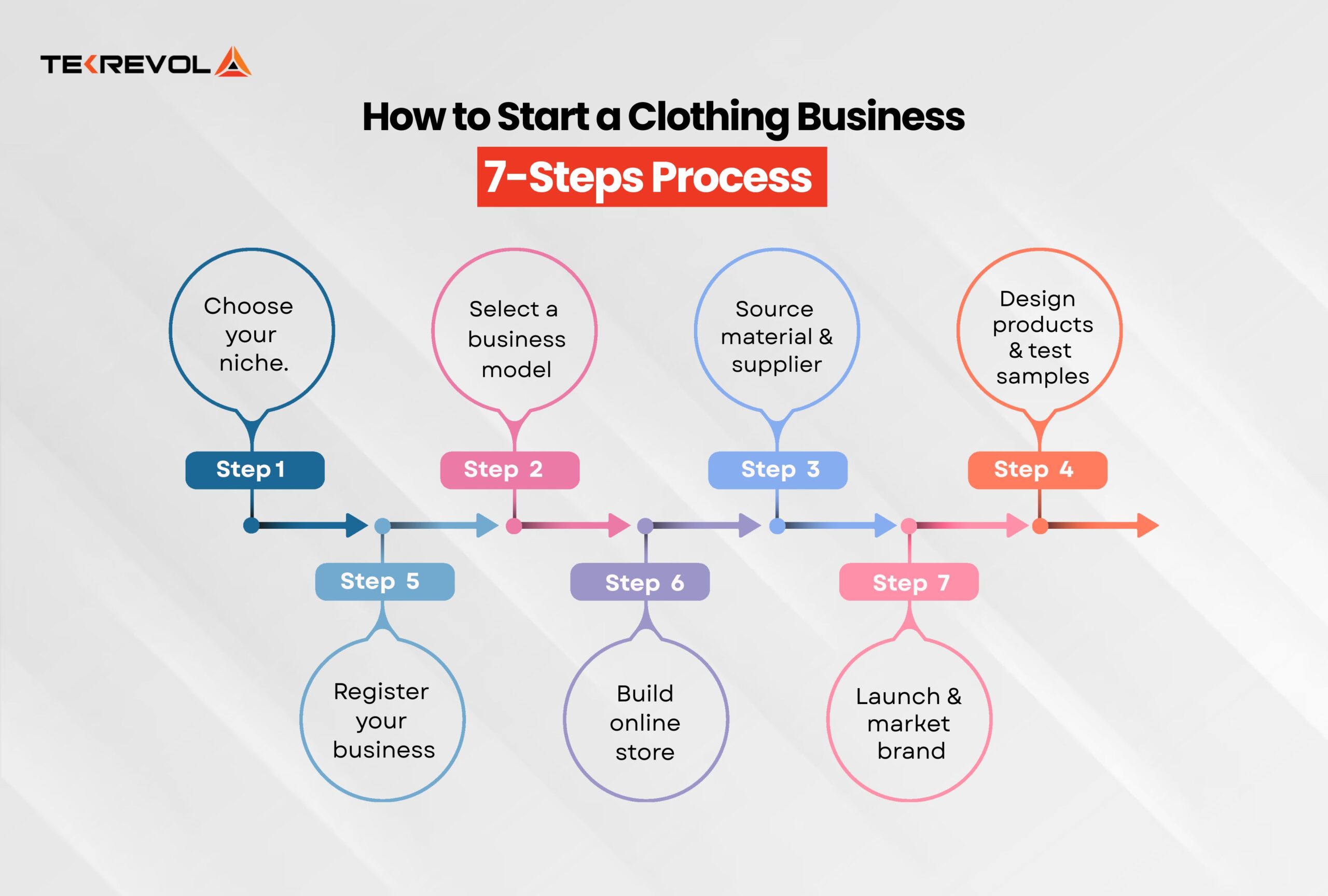
1: Define Your Niche & Brand Identity
Your niche is what sets your brand apart. It could be vintage streetwear, sustainable basics, or bold festival fashion.
Clothing Business Examples for Different Niches:
- A Gen Z loungewear brand with bold messaging
- An eco-conscious yoga apparel label for millennial moms
Once clear on what you sell and who you’re selling to, craft your brand identity. It includes your name, logo, voice, and vibe. The brand identity needs to speak to your audience immediately.
Clothing brands that target a defined niche grow 2.3× faster than those with broad, unclear positioning. (Source: Brandsgateway)
Tools to Help:
- Namelix (brand name ideas)
- Canva (logo + mood board)
- Pinterest (brand voice + aesthetic)
2: Choose a Business Model (POD, Pre-order, Inventory)
The way you fulfill orders impacts how much you spend, what you control, and how fast you grow. Choose between Print-on-Demand, Pre-order, or Holding Inventory.
By eliminating inventory, warehousing, and bulk production costs, POD can cut upfront expenses by as much as 80%, as many brands only pay for production after a sale is made. (Source: Reddit/r/startupfashion)
Clothing Business Model Comparison:
| Model | Tools | Pros | Cons |
| POD | Printify, Printful | Low risk, no inventory | Lower margins, less control |
| Pre-order | Kickstarter | Validates demand before production | Delayed fulfillment |
| Inventory | Alibaba, Faire | Full control, higher profit per item | Higher upfront investment |
3: Design, Sample & Test Your Products
Start small by focusing on 3 to 5 core products that reflect your brand. You can also create mockups or prototypes, order samples, and get real feedback before committing to production.
Tip: Brands that launch with 3–7 SKUs often see better early traction than those with larger catalogs. (Source: TrendHijacking.com)
Checklist:
- Adobe Illustrator or Canva (designs)
- Printful sample order
- Instagram polls or Google Forms (test feedback)
4: Source Materials and Manufacturers
Identifying a suitable supplier involves balanced consideration of quality, cost, and reliability. Locate the right one by requesting samples, confirming delivery schedules, and ensuring that production is carried out ethically.
Where to Look:
- Alibaba, IndiaMart (bulk suppliers)
- Maker’s Row (US-based production)
- Brandsgateway (luxury dropshipping)
5: Register Legal Entity & Brand Rights
Before you launch, protect your business. To run legally, register your business and secure the rights to your name and logo. You’ll need a business structure, tax ID, and potentially a trademark.
Nearly 47% of new founders delay legal setup, risking domain or brand name loss. (Source: Reddit r/smallbusiness)
To-Do List:
- Register your entity (LLC/Sole Prop)
- File a trademark (USPTO for U.S.)
- Buy your domain and lock social handles
6: Build Your eCommerce Store (Shopify, WooCommerce)
Your website is your store window. Build it right.
Shopify is beginner-friendly and fast to set up, powering over 4.4 million stores, many of them fashion-first (Source: Statista).
WooCommerce offers flexibility and is ideal for WordPress users. Custom platforms are best for long-term scalability.
Still not sure which to choose? Here’s a full breakdown of Shopify vs. WooCommerce vs. Magento to help you decide.
7: Launch & Market Effectively
Launch day is just the beginning. Build pre-launch buzz on social, partner with a reliable digital marketing agency, hire micro-influencers, and use user-generated content to fuel your growth.
Marketing Toolkit:
- TikTok, Instagram (short-form launch content)
- Klaviyo, Mailchimp (email)
- Google Analytics (to track what works
How Much Does It Cost to Start a Clothing Brand in 2025?
The cost to start a clothing business ranges from $500 to over $50,000, depending on your business model.
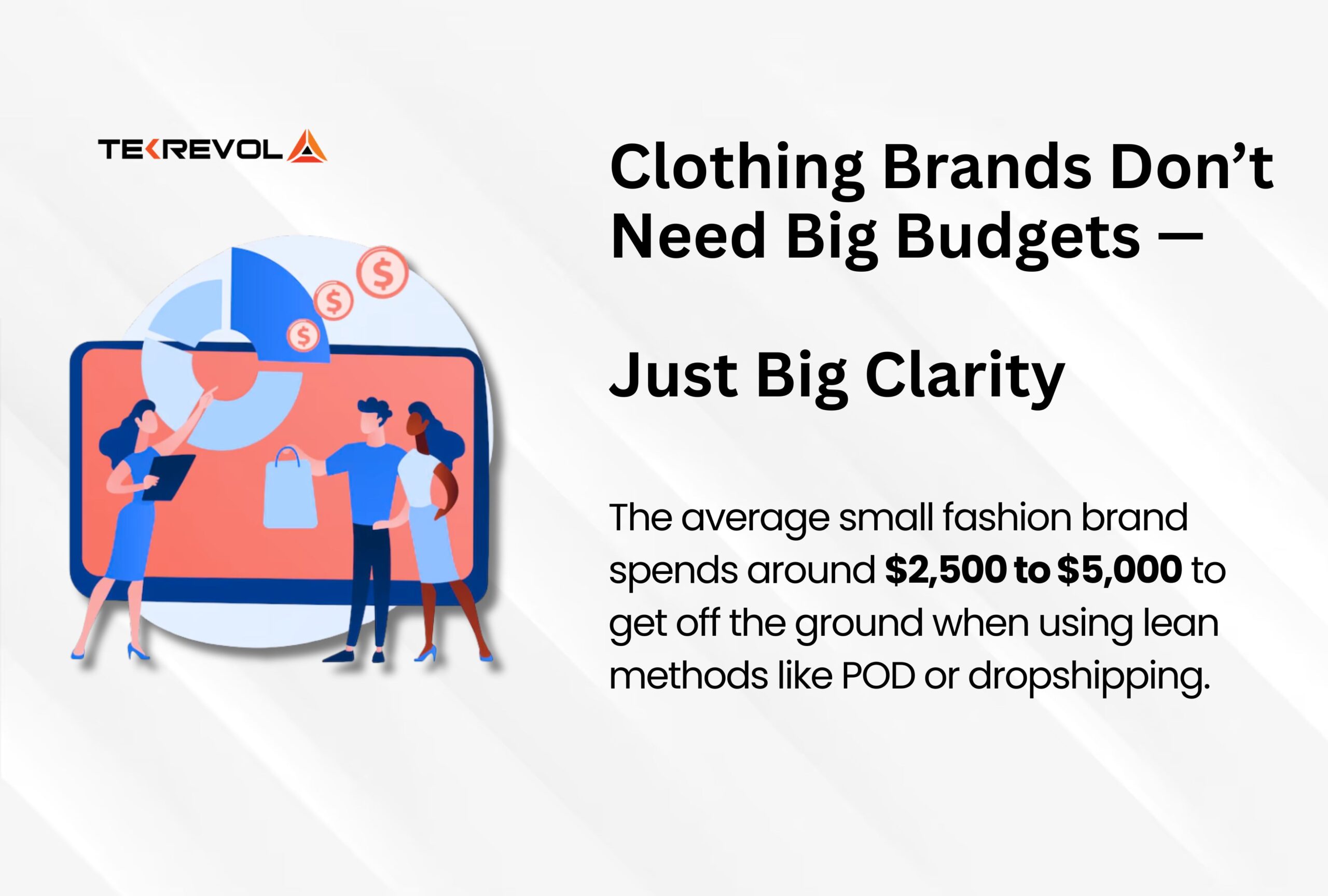
Let’s break down typical startup expenses so you can plan based on your vision and budget.
Clothing Business Startup Cost Breakdown (2025)
| Expense
Category |
POD / Home-Based | Wholesale / Inventory-Based | Luxury / Custom Label |
| Branding & Logo | $0 – $150 | $200 – $500 | $500 – $1,000 |
| Sample & Design Prototyping | $50 – $300 | $500 – $1,500 | $1,000 – $3,000 |
| Website / Store Setup | $0 – $250 (DIY) | $500 – $2,000 | $2,000 – $10,000+ |
| Inventory / Fulfillment | $0 (POD) | $2,000 – $10,000+ | $5,000 – $20,000+ |
| Legal & Licensing | $100 – $500 | $500 – $1,000 | $1,000 – $3,000 |
| Marketing & Launch | $100 – $500 | $500 – $2,000 | $2,000 – $10,000+ |
- If you’re wondering how to start a clothing business with no money, POD and pre-order models let you skip inventory completely.
- Founders building luxury brands should budget for higher creative, legal, and sampling costs upfront.
- Many successful brands start small, then reinvest profits into expansion.

How to Start a Clothing Business from Home?
To start a small clothing business from home in 2025, use a lean strategy:
Choose a print-on-demand model, focus on a specific niche, and build your audience on top social platforms like TikTok or Instagram. This lets you test ideas without inventory risk and scale gradually as demand grows.
Market data indicates that over 60% of new fashion entrepreneurs are already doing this, launching from home with print-on-demand to avoid upfront costs and streamline operations.
Small Clothing Business from Home: Strategy Overview
| Component | Recommended Option |
| Fulfillment | Print-on-Demand (e.g., Printify) |
| Design Tools | Canva |
| Store Platform | Shopify Lite or Etsy |
| Sales Channels | TikTok, Instagram, Pinterest |
| Marketing Focus | Short-form video, niche hashtags, community content |
| Startup Budget | $300–$800 |
According to recent market research by Gitnux, more than 60% of new fashion entrepreneurs launch from home using print‑on‑demand platforms.
Key Advantages
- No need to hold inventory or ship products yourself
- Start with only a few designs to test demand
- Content-focused growth through social-first discovery
This model allows you to launch and grow without touching inventory. Later, you can expand with on-demand app development to offer a mobile shopping experience as your brand scales.
How to Start a Luxury Clothing Brand?
To start a luxury clothing brand in 2025, focus on exclusivity, high-quality materials, and a compelling brand story. Premium packaging, influencer partnerships, and legal protection are essential to building credibility and trust.
The luxury space is competitive but rewarding, with higher margins, fewer SKUs, and deeply loyal customers. Grand View Research reports that the luxury apparel market will grow at a 4.3% CAGR through 2030, driven by digitally native premium brands.
Luxury Clothing Brand: Strategy Overview
| Component | Recommended Option |
| Production Model | Small-batch or made-to-order |
| Design Standards | Premium materials, signature cuts, bespoke details |
| Sales Platform | Shopify Plus, custom mobile app |
| Legal Protection | Trademark + design patents |
| Marketing Focus | Influencer storytelling, editorial content |
| Packaging & UX | High-end packaging, custom unboxing, VIP access |
What Sets Luxury Brands Apart
- Brand is the product: visuals, values, and voice must align.
- Legal protections matter more when copycats target upscale concepts.
- Luxury customers expect consistency, exclusivity, and elegance at every touchpoint
Whether you’re launching a capsule collection or a full-scale fashion house; success comes from refined experiences, not mass production.
What’s the Best Platform to Start a Clothing Brand?
The best platform choice to start your clothing brand depends on how much control you want and how quickly you plan to launch.
Shopify is ideal for beginners who want speed and simplicity. WooCommerce gives more flexibility for developers, BigCommerce works well for scaling large product catalogs, and Wix is perfect if visual design is your top priority.
Each platform has strengths, so your choice should match your brand’s size, style, and technical comfort level.
Here’s how they compare at a glance:
Platform Comparison for Apparel Startups (2025)
| Platform | Best For | Monthly Cost | Ease of Use | Flexibility |
| Shopify | Beginners & quick launches | $39+ | Very Easy | Moderate |
| WooCommerce | Tech-savvy, WordPress-based users | $0–$100+ | Moderate | High |
| BigCommerce | Growing, multi-channel brands | $39–$105+ | Moderate | High |
| Wix | Small shops with visual branding | $17–$35 | Easy | Low–Moderate |
In 2024, over 28% of all online fashion stores were powered by Shopify, more than any other platform. (Source: Statista)
Best Platform Choice for First-Time Clothing Brands
If you’re just starting, Shopify offers the easiest path. To start a Shopify store, pick a theme, add your products, and launch in days, no developer needed.
More tech-savvy? WooCommerce is a great fit if you’re already using WordPress and want more customization. BigCommerce works well for growing brands with large inventories, while Wix suits small, design-driven labels looking for creative freedom with minimal complexity.

How to Market Your Clothing Brand Online in 2025?
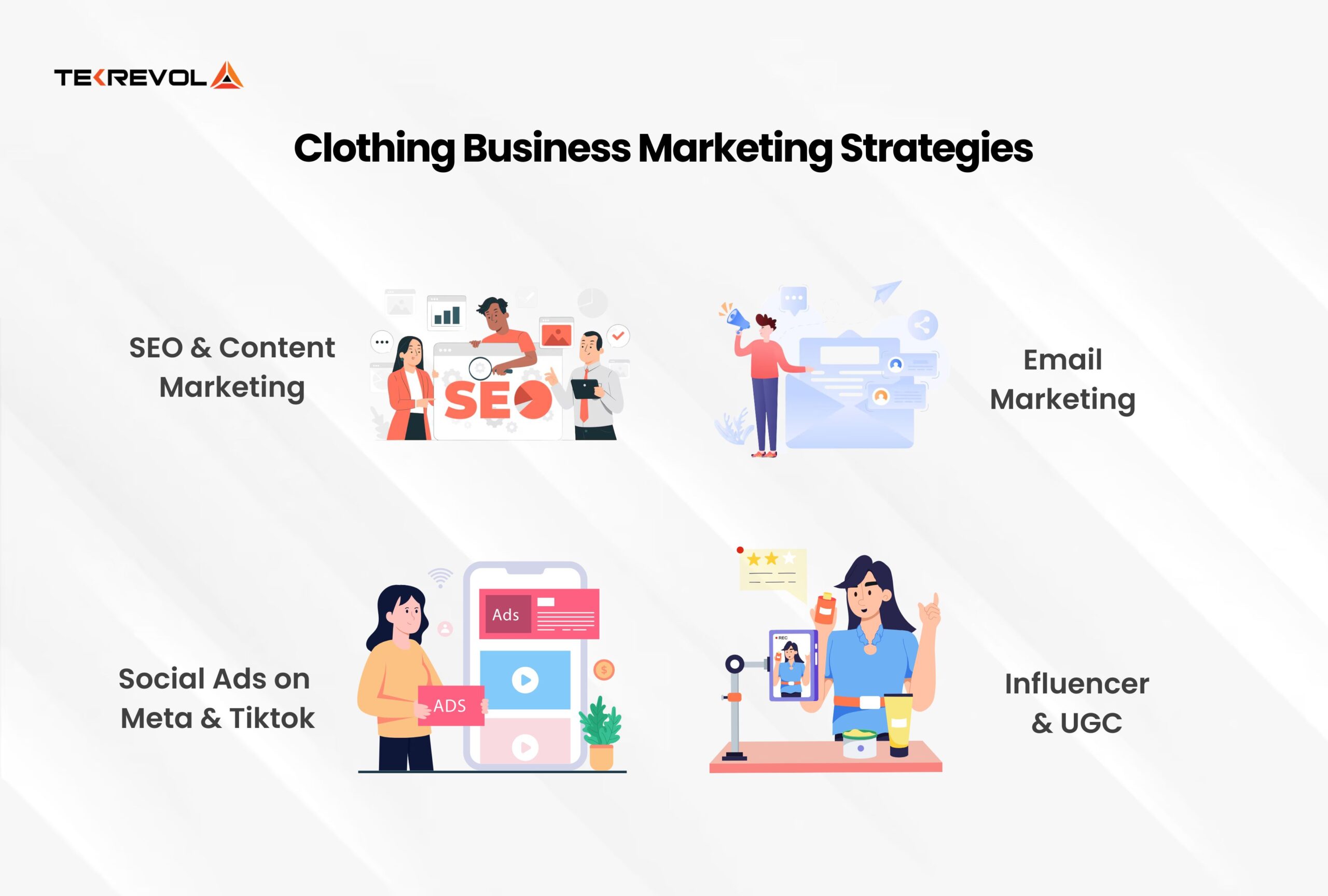
To market your clothing brand online in 2025, build a multichannel strategy that blends organic content, paid ads, influencer collaborations, and email marketing. No single platform is enough, as real growth comes from consistency across multiple touchpoints.
Here’s how to build visibility and loyalty across the full customer journey.
-
SEO & Content Marketing
Organic visibility starts with your website. Blog posts, landing pages, and product descriptions help your brand rank for niche terms like eco-friendly gymwear or gender-neutral streetwear. The more relevant, high-quality content you create, the easier it becomes for customers to find you through search.
53% of all website traffic for fashion eCommerce brands still comes from organic search. (Source: SEMrush, 2024 eCommerce Industry Report)
Tips to grow organically:
- Optimize product pages with keywords and customer questions
- Write blogs like “How to style [your product]” or “Sustainable fashion trends 2025”
- Include internal links and schema to improve AEO performance
2) Social Ads (Meta, TikTok, Pinterest)
Paid social is one of those digital marketing strategies that helps you reach new buyers fast. Short-form videos, influencer partnerships, and retargeting ads are the go-to formats for clothing brands.
Our 2024 performance data shows that brands using TikTok Ads saw up to a 32% higher ROAS compared to static Meta ads.
Tactics that convert:
- Reels and TikToks with try-ons, transitions, or customer stories
- Pinterest campaigns for holiday or seasonal drops
- Meta carousels for bundles or product ranges
3) Influencer & UGC Strategy
Customers trust people more than logos. Partner with micro-influencers and encourage buyers to share photos, unboxings, and style tips featuring your brand.
Multiple studies consistently show that brands using UGC in paid and organic campaigns see up to 4× higher click‑through rates than those relying on polished studio content.
How to build social proof fast:
- Send products to 10 micro-creators with <10K followers
- Create a branded hashtag and showcase customer content
- Offer repost incentives or feature buyers on your store
4) Email & Retention Campaigns
While most focus on new customers, retention is where profit lives. Automated emails help you turn one-time shoppers into loyal repeat buyers.
According to several industry sources a comprehensive email marketing statistics roundup reports an average ROI of $42 for every $1 spent, highlighting its efficiency as a top-performing digital marketing channel
Key flows to set up:
- Welcome series (with story + incentive)
- Abandoned cart reminders
- Thank-you emails with a cross-sell
- Re-engagement emails after 30–60 days
Tip: Retention channels like email can be enhanced with the right digital marketing services provider.
What Are the Most Common Challenges When Starting a Clothing Business?
The most common challenges when starting a clothing business include low profit margins, inventory risk, high marketing costs, and inconsistent cash flow. These issues often impact new founders in their first year, especially if they lack a lean launch strategy.
According to our internal analysis of 2023–24 startups, 43% failed to reach profitability within 18 months, primarily due to operational inefficiencies and weak financial controls.
1) Low Profit Margins Limit Growth Early On
Between production, shipping, and marketing costs, most new brands operate on tight margins. Print-on-demand and wholesale models leave little room for error, especially for low-ticket products.
- Premium materials increase baseline costs
- Fees and transaction charges reduce net revenue
- Discounts and shipping offers eat into your margins
2) Inventory Risk Can Lead to Financial Loss
Ordering inventory upfront can backfire. Styles go out of trend quickly, and holding stock ties up your capital.
- Unpredictable demand results in overstock or missed sales.
- Storage, returns, and size variations increase complexity.
- Trends shift fast. What’s hot today might sit unsold tomorrow.
3) Marketing Spend Is High and ROI Is Unpredictable
Digital ads are effective but expensive. Without a clear audience or strong content, your cost-per-click (CPC) and cost-per-acquisition (CPA) can spiral quickly.
- Social ads require ongoing testing and budget.
- ROAS (Return on Ad Spend) may be low during early campaigns.
- Creators and influencers also require upfront compensation.
4) Cash Flow Is Inconsistent for New Brands
Even with solid sales, poor cash management causes many brands to stall. This is especially true when payments are delayed or expenses outpace revenue.
- Pre-orders reduce risk but delay income
- Refunds, platform holds, and supplier costs create payment gaps
- Unexpected expenses (like redesigns or reshoots) hit early budgets hard
How TekRevol Helps You Start a Clothing Business the Smart Way
If you’re figuring out how to start a clothing business and want it built for scale, TekRevol can help.
We work with fashion startups and direct-to-consumer brands to create digital storefronts that look great, load fast, and convert better.
Whether you’re launching with print-on-demand, managing your inventory, or need a customized clothing business plan PDF guide, our eCommerce website development services help you go live with the right structure, tools, and integrations in place.
From MVPs to full-scale fashion platforms, we help you build what you need now, while preparing for the growth ahead.


